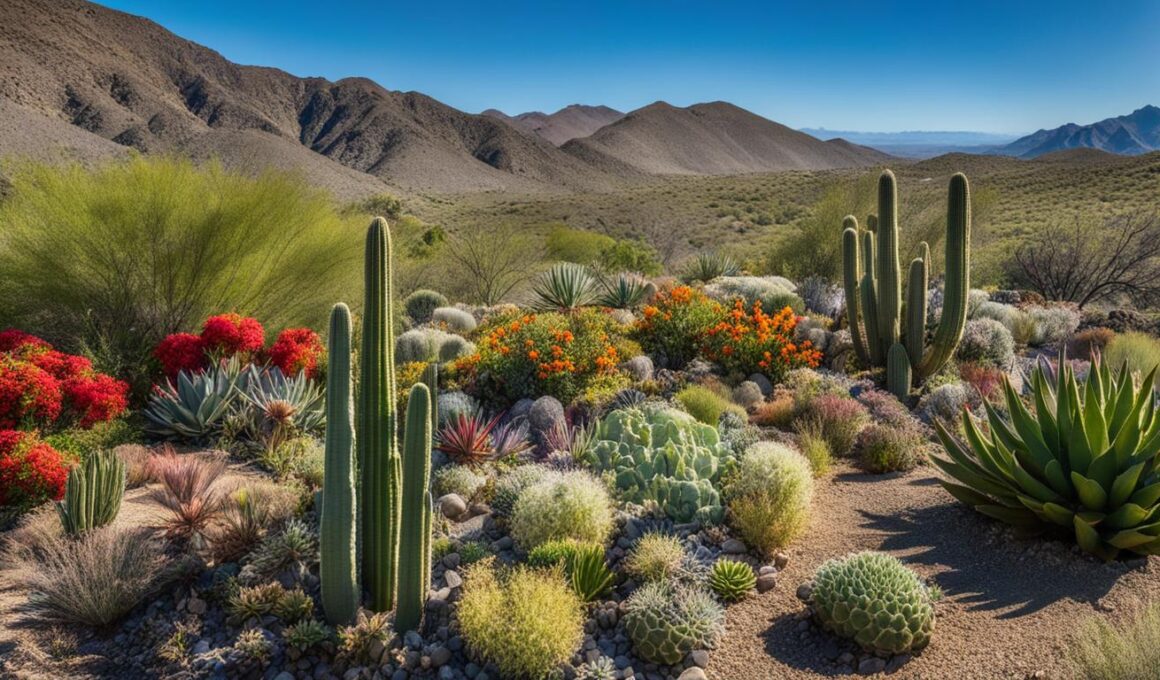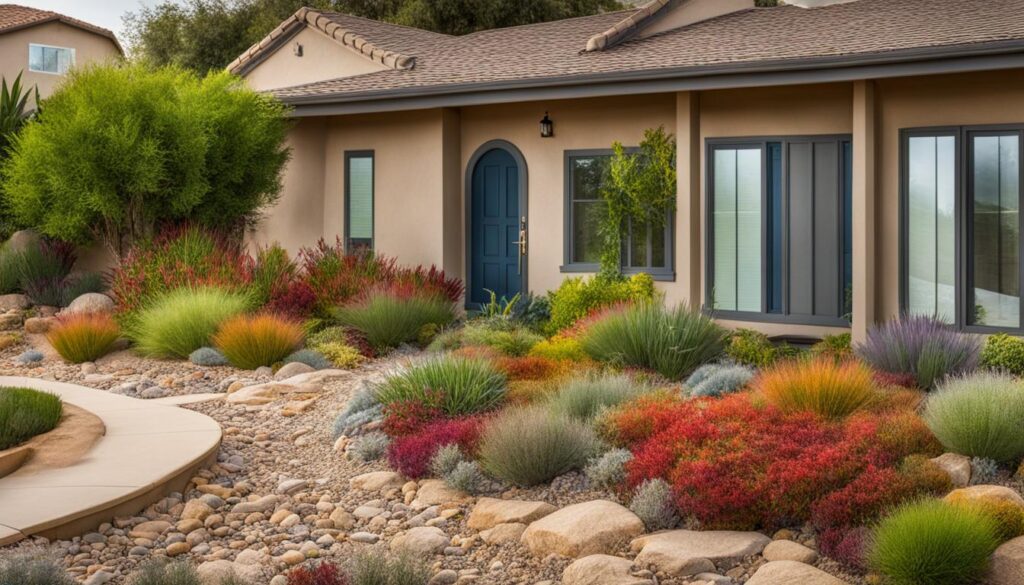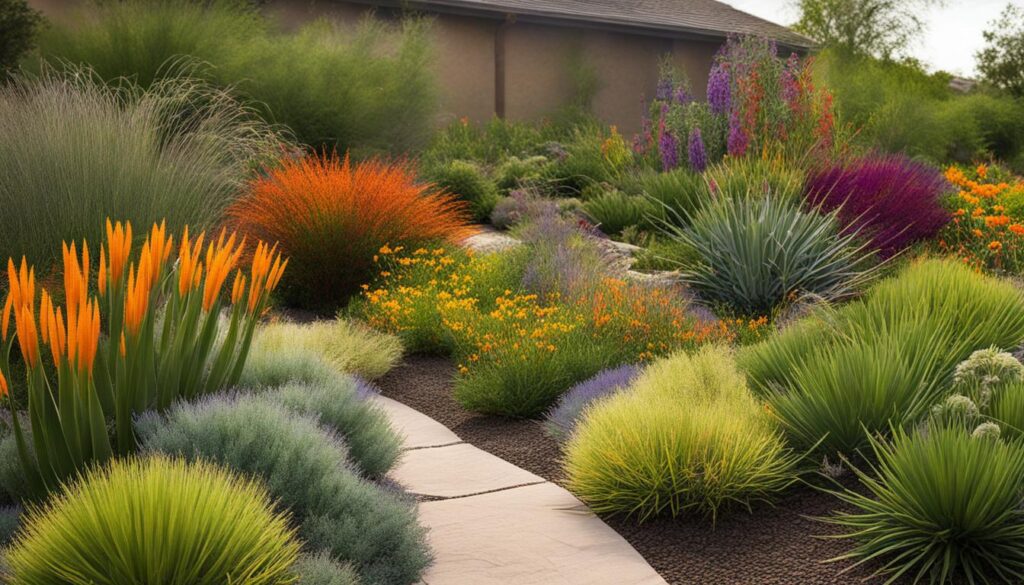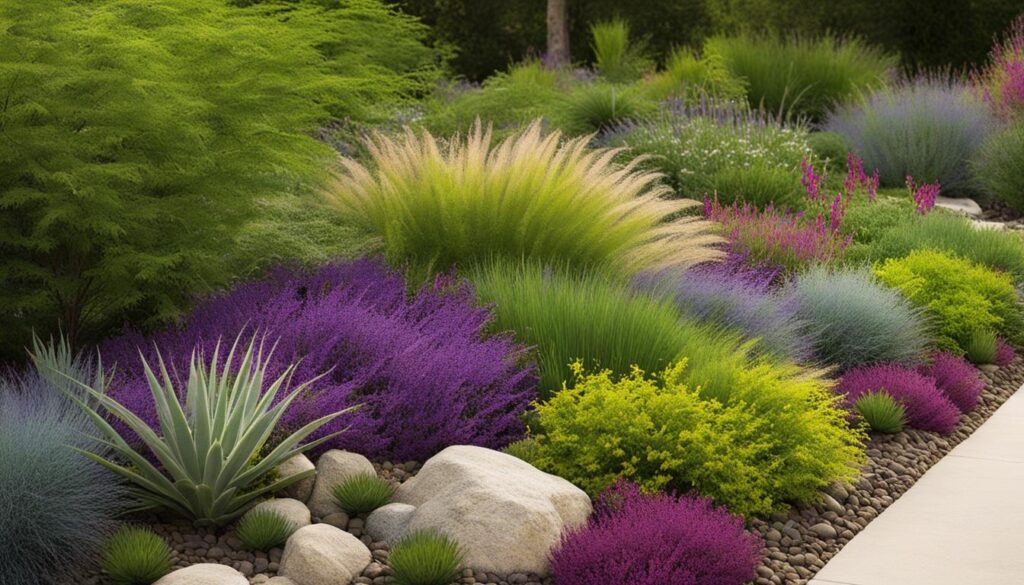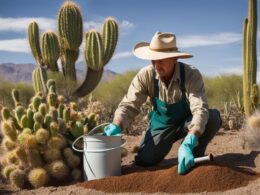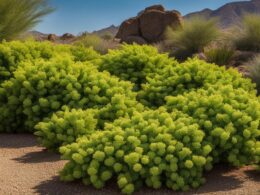Are you looking to create a beautiful and sustainable garden while conserving water? Look no further than xeriscape gardening! Xeriscape landscaping is a water-wise gardening technique that uses minimal water to thrive, making it perfect for areas prone to drought and for those who want to practice water conservation. By incorporating native plants and drought-tolerant species, you can create a vibrant and low-maintenance xeriscape garden that not only saves water but also promotes biodiversity.
Key Takeaways:
- Native plants and drought-tolerant species are ideal for xeriscape gardens.
- Xeriscape landscaping helps conserve water and promotes biodiversity.
- By grouping plants based on their water needs and eliminating excessive lawn grass, you can further reduce water usage.
- Proper maintenance, including watering, soil improvement, and pest management, is essential for a thriving xeriscape garden.
- Creating visual impact with low-lying bedding plants adds beauty to your xeriscape garden.
Understanding Xeriscape Landscaping Principles
Xeriscape landscaping is a sustainable approach to gardening that conserves water and promotes healthy landscapes. To create a water-wise garden, it is essential to understand the principles of xeriscape landscaping. Let’s explore these principles and how they can be applied to your garden.
Site Analysis
Before starting a xeriscape garden, it is important to conduct a thorough site analysis. Consider the topography, exposure, and soil conditions of your garden. Identify areas that receive full-day sun and areas that are more shaded. This analysis will help determine the appropriate plants for each location.
Plant Grouping
In xeriscape landscaping, grouping plants based on their water needs is crucial. Place drought-tolerant plants in areas exposed to full-day sun where they can thrive without excessive watering. Keep more delicate plants closer to a water source or in shaded areas where they require less water. By grouping plants with similar water requirements, you can ensure efficient water usage and healthier plants.
Turf Grass Reduction
Turf grass can be a significant water consumer in a garden. Consider reducing or eliminating lawn grass areas in your xeriscape garden. Instead, opt for low-maintenance alternatives such as ground covers, native plants, or hardscaping elements like gravel or mulch. This not only saves water but also reduces the need for fertilizers, pesticides, and excessive maintenance.
By understanding these xeriscape landscaping principles, you can create a water-wise garden that is not only environmentally friendly but also visually appealing. Implementing proper site analysis, plant grouping, and turf grass reduction will help conserve water and promote a thriving and sustainable landscape. It’s time to transform your garden into a beautiful oasis while also doing your part for water conservation.
Recommended Native Plants for Xeriscape Gardens
When planning a xeriscape garden, it is important to choose plants that are well-suited for the local climate and require less water. Native plants are an excellent choice for xeriscape gardens as they have adapted to the specific conditions of the region. These plants not only help conserve water but also contribute to the biodiversity of the area.
Flowering Plants
- Amelanchier
- Aronia
- Buddleia
- Cotoneaster
Ground Covers
- Red bird of paradise
- Viburnum
- Feather reed grass
- Fescue
Shrubs
- Potentilla
- Juniper
- Fountain grass
- Maiden grass
Trees
- Switch grass
Native plants are not only beautiful but also have deep root systems that help prevent erosion and improve soil health. They are more resistant to pests and diseases, reducing the need for pesticides. Additionally, native plants provide food and shelter for local wildlife, further enhancing the biodiversity of your xeriscape garden.
By incorporating these recommended native plants into your xeriscape garden, you can create a sustainable and water-efficient landscape that thrives in the local climate. These plants offer a variety of colors, textures, and heights, allowing you to design a visually appealing garden while conserving water.
Incorporating Non-Native Drought-Tolerant Plants
While native plants are ideal for xeriscape gardens, there are also non-native drought-tolerant plants that can thrive in these water-conserving landscapes. By carefully selecting non-native varieties that are adapted to the local climate, you can enhance the beauty and diversity of your xeriscape garden.
One of the non-native options for a xeriscape garden is Lily turf. This clumping ground cover adds lushness and texture to the landscape while requiring minimal water once established. With its vibrant green foliage and ability to withstand dry conditions, Lily turf can be a valuable addition to your garden.
“In addition to Lily turf, various herbs can also be incorporated into your xeriscape garden,” says Jane Doe, a landscape designer with expertise in xeriscape gardening. “Herbs like rosemary, lavender, and thyme are not only drought-tolerant but also offer aromatic fragrances and culinary benefits.”
These non-native drought-tolerant herbs not only conserve water but also provide a sensory experience and a touch of culinary delight. With their striking aromas and attractive foliage, they can serve as focal points or borders in your xeriscape garden, adding both functionality and beauty.
Creating Visual Impact with Xeriscape Bedding Plants
Xeriscape gardens are not only environmentally conscious but can also be visually stunning. By incorporating a variety of ground covers, bedding plants, and low-lying plants, you can create a xeriscape garden that is both colorful and visually impactful. These plants not only thrive in drought conditions but also add interest and texture to your landscape.
One way to enhance the visual appeal of your xeriscape garden is by using ground covers. Sedum, with its vibrant colors and succulent leaves, can create a lush carpet effect that complements other plants. Pachysandra, with its glossy green leaves, is an excellent choice for shady areas, while lilyturf provides a delicate ground cover with its grass-like foliage.
Bedding plants are another great option to add pops of color and visual interest to your xeriscape garden. Santa Barbara daisy, with its bright yellow flowers, can create a cheerful and vibrant display. False shamrock, with its purple triangular leaves, adds a unique touch, while purple poppy-mallow stands out with its vibrant pink blooms. These low-lying plants can be arranged in patterns or different heights to create visual impact and draw attention to specific areas of your garden.
When selecting bedding plants, keep in mind their water needs and ensure they are compatible with the local climate. Choose colorful plants that are well-suited for xeriscape gardening and can thrive in low-water conditions. By carefully selecting and arranging ground covers and bedding plants, you can create a visually striking xeriscape garden that requires minimal maintenance and conserves water.
How Can Xeriscape Landscaping with Native Plants Promote Biodiversity in Gardens?
Xeriscape landscaping for biodiversity encourages the use of native plants that require minimal water and create a sustainable ecosystem. By reducing the need for irrigation and chemical inputs, this approach promotes a healthier environment for diverse plant and animal species to thrive in gardens.
Xeriscape Gardening Tips and Maintenance
Once you have created your xeriscape garden, it is important to maintain it properly to ensure its long-term health and beauty. Here are some gardening tips to help you maintain your drought-tolerant landscape:
- Follow a watering schedule: Rather than watering on an arbitrary schedule, it is best to water your plants based on their specific needs. Drought-tolerant plants typically require less water than traditional plants, so it is important to avoid overwatering. Consider using drip irrigation systems to efficiently control the watering and direct water only to the plants that need it.
- Improve your soil: Good soil is crucial for a successful xeriscape garden. Improve water penetration and retention by adding compost and organic matter to the soil. This will help the plants better absorb water and nutrients, reducing the need for excessive watering.
- Use mulch: Mulching is a great practice in xeriscape gardening. Apply a layer of mulch around your plants to help conserve moisture, moderate soil temperature, and suppress weed growth. Organic mulch, such as wood chips or straw, can also break down over time, enriching the soil with nutrients.
- Manage pests effectively: Proper pest management is essential for maintaining a healthy xeriscape garden. Monitor your plants regularly for signs of pests or diseases, and take appropriate action if necessary. Consider using natural pest control methods, such as companion planting or introducing beneficial insects, to minimize the use of chemical pesticides.
By following these gardening tips and practicing regular maintenance, you can ensure the continued success of your xeriscape garden. With proper care, your drought-tolerant landscape will thrive, conserve water, and provide a beautiful, sustainable environment for years to come.
Gardening Quote:
“A xeriscape garden is not only about saving water, but also about creating a thriving ecosystem that supports local wildlife and biodiversity. By choosing drought-tolerant plants and practicing water-wise techniques, you can make a positive impact on the environment while enjoying the beauty of a sustainable landscape.” – Unknown
Conclusion
Xeriscape landscaping is a smart and sustainable way to conserve water, enhance the beauty of your garden, and support biodiversity. By utilizing native plants and drought-tolerant varieties, you can create a landscape that not only thrives in arid conditions but also requires minimal water and maintenance.
With xeriscape gardening, you have the power to make a positive impact on water conservation. By eliminating or reducing lawn grass areas, grouping plants based on their water needs, and incorporating a diverse range of native and drought-tolerant plants, you can create a vibrant and eco-friendly landscape.
Remember, xeriscape gardens are not limited to desert plants. There is a wide selection of beautiful and attractive native plants that are well-adapted to your local climate and require less water. By embracing xeriscape landscaping principles, you can transform your garden into a haven that flourishes while saving water.
So, take the first step towards sustainability and create a xeriscape garden that conserves water, supports native plants, and enhances your outdoor space. By implementing water-wise gardening techniques and choosing the right plants, you can enjoy a thriving and environmentally friendly landscape for years to come.





